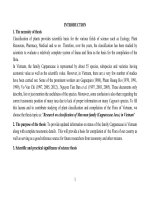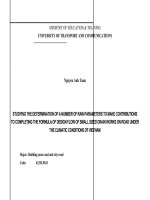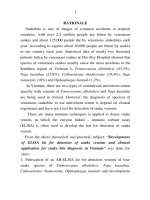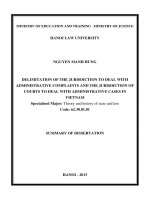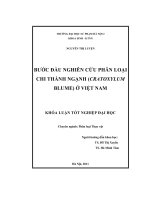nghiên cứu phân loại họ màn màn (capparaceae juss.) ở việt nam bản tóm tắt tiếng anh
Bạn đang xem bản rút gọn của tài liệu. Xem và tải ngay bản đầy đủ của tài liệu tại đây (277.76 KB, 31 trang )
INTRODUCTION
1. The necessity of thesis
Classification of plants provides scientific basis for the various fields of science such as Ecology, Plant
Resources, Pharmacy, Medical and so on Therefore, over the years, the classification has been studied by
scientists to evaluate a relatively complete system of fauna and flora as the basis for the compilation of the
flora.
In Vietnam, the family Capparaceae is represented by about 55 species, subspecies and varieties having
economic value as well as the scientific value. However, in Vietnam, there are a very few number of studies
have been carried out. Some of the prominent workers are Gagnepain (1908), Pham Hoang Ho (1970, 1991,
1999), Vo Van Chi (1997, 2005, 2012) , Nguyen Tien Ban et al. (1997, 2003, 2005). These documents only
describe, list or just mention the usefulness of the species. Moreover, some confusion is also there regarding the
correct taxonomic position of many taxa due to lack of proper information on many Capparis species. To fill
this lacuna and to contribute studying of plant classification and compilation of the Flora of Vietnam, we
choose the thesis topic as: "Research on classification of Man man family (Capparaceae Juss.) in Vietnam"
2. The purpose of the thesis: To provide updated information on status of the family Capparaceae in Vietnam
along with complete taxonomic details. This will provide a basis for compilation of the Flora of our country as
well as serving as a good reference source for future researchers from taxonomy and other streams.
3. Scientific and practical significance of science thesis
1
* Scientific significance: The results will contribute to complete the knowledge of Man man (Capparaceae
Juss.) in Vietnam. This is an important step to prepare the "Flora of Vietnam". Besides, the results of the study
will serve for further research on various aspects of Capparaceae.
* Practical significance: The results of the thesis will provide a scientific basis for various fields like
Agriculture - Forestry, Pharmacology, Plant Resources, Biodiversity and others.
4. The new point of the thesis
- Attempt has been made for the proper documentation and classification of Capparaceae in Vietnam along with
complete taxonomic details. The family includes two subfamilies, 4 tribes, 6 genera, 49 species, subspecies and
2 varieties. The information pertaining to these taxa have been updated along with the revised nomenclature
terms (if any), references, voucher specimen details, taxonomic descriptions, color photographs and line
drawings.
- 1 new species was discovered during the study. Furthermore, 1 species, 1 subspecies have been reported new
to the flora of Vietnam. Moreover, the presence of two species and one subspecies was confirmed in Vietnam
which was doubtfully reported in Vietnam. Overall, one genus, 6 species, and 1 variety were recorded as
endemic to Vietnam.
- Additionaly, characterization of pollen grain morphology of some taxa of Capparaceae was also done. 24
species belonging to 4 genera were studied for this purpose. Moreover, seed morphology was also studied for
18 species belonging to 4 genera. This will contribute to the proper identification of the species.
- Nucleotide sequence were generated for many Capparaceae taxa and using computer programs such as
ClustalX 1.83, Paup 4.0, Mr Bayes and others, attempt have been made to generate phylogentic trees to
demonstrate the relationship between different species in Vietnam
5. The structure of the thesis
2
The thesis consists of 116 pages, 63 line drawings, 21 maps, 8 tables and 64 pages color photos. It was
presented under the following headings: Introduction (3 pages), chapter 1: review of the literature (20 pages),
chapter 2: the objective, content and research methods (11 pages), Chapter 3: Research Results (page 81),
conclusions (1 paper), list of tables, list of figures, list of maps, list of color photos, list of abbreviations
herbarium, list of published works authors (9 projects), references (125), scientific names, Vietnamese name,
appendix 1: distribution map of the species in the genus (21 maps) , appendix 2: gene sequence data analysis
showing relationship between genera of Capparaceae.
CHAPTER 1: REVIEW DOCUMENT
1.1. Position of Capparaceae in Magnoliophyta
Before Capparaceae established, Linnaeus (1753) named a few genera and species, which were later placed
in Capparacee as Capparis, Cleome and Crateva.
Jussieu (1789) named Manman as Capparaceae Juss. that consists: Cleome, Cadaba, Capparis, Sodada,
Crateva, Morisonia. Then there are many classification systems refers to their location of Manman in super
ordo: Bentham & Hooker (1862) placed in subclass Polypetalae (more petals), Thalamiflorae; Dalla Torre &
Harms (1900-1907) and Melchior (1964) classified in subclass Archichlamydeae; Hutchinson (1969) placed in
Lignosae; Dahlgren & Thorne (1983) ranked in Violiflorae. The Cronquist system, Heywood, Takhtajan,
Young ranked in Dilleniidae subclass.
3
Regarding the taxonomic position of Capparaceae, whether belongs to or not belongs to Capparales,
taxonomists also have different views, but as per the most recognized views of most authors, Capparaceae is
kept under Capparales and having close relationships with Brassicaceae and Moringaceae
1.2. The classification system of Capparaceae Juss.
By studying the classification system of the authors, 2 opinion were noticed which are as follows
1.2.1. Divide Capparaceae into Tribes, then divide Genus and lower ranks
* De Candolle system (1824): divided Manman family (Ordo - Capparideae) to 2 tribes.
- Cleomeae: herb, glandular hair, Leaves with palmately compound, fruit a capsule, include 5 genus: Cleomella,
Peritoma, Gynandropsis, Cleome (2 Sectio: Pedicellaria, Siliquaria), Polanisia (2 sectio: Brachystyla, Stylaria). -
Capparideae: shurb or tree; fruit a berry; include 12 gunes: Crataeva, Niebuhria (2 sectio: Crataevaformes,
Capparoideae), Boscia, Cadaba (2 sectio: floribus apetalis, floribus tetrapetalis), Schepperia, Sodaba, Capparis (6
sectio: Eucapparis, Capparidastrum, Cynophalla, Calanthea, Breyniastrum, Quadrella), Stephania, Morisonia,
Thylachium, Hermupoa, Maerua. Some Sectio divided smaller (subsectio) as Siliquaria (2), Eucapparis (4),
Breyniastrum (2).
Basis for De Candolle divides 2 tribes is main characteristics and easily recognizable.
* Bentham & Hooker system (1862): Capparacae also divided 2 tribes:
- Cleomeae: herb, fruit a capsule, include 9 genus: Dactylaena, Cleome (5 Sectio: Physostemon, Dianthera,
Peritoma, Siliquaria, Buhsia), Cleomella, Cristatelia, Isomeris, Polanisia (4 Sectio: Eupolanisia, Ranmanissa,
Corynandra, Tetratelela), Gynandropsis, Wislizenia, Oxystylis. - Cappareae: shurb or tree; fruit a berry or drupe;
4
include 14 gunes: Thylachium, Steriphoma, Morisonia, Niebuhria, Maerua (2 Sectio: Maerua, Streblocarpus), Cadaba
(3 Sectio: Eucadaba, Desmocarpus, Schepperia), Boscia, Capparis (9 Sectio: Eucapparis, Sodaba, Capparidastrum,
Cynophalla, Busbeckia, Breyneastrum, Calanthea, Quadrella, Beautempsia), Apophyllum, Atamisquea, Roydsia,
Crateva, Ritchiea, Tovaria.
* Eichler (1865) in "Flora Brasiliensis" divided Capparaceae into 3 tribus: Cleomeae: herb, fruit a capsule:
Dactylaena, Physostemon, Cleome, Gynandropsis. Cappareae: shurb, fruit a berry: Crateva, Steriphoma, Capparis (9
Subgen.: Quadrella, Breyniastrum, Colicodendron, Calanthea, Beautempsia, Mesocapparis, Calyptrocalyx,
Capparidastrum, Cynophalla). Roydsieae:shurb, fruit a drupe
* Takhtajan (2009) divided into Capparaceae and Cleomaceae with subfamilies and tribes:
- Capparaceae: Cappareae: Capparis, Tirania, Crateva, Eudenia, Cladostemon, Dhofaria, Ritchiea, Belencita,
Steriphoma, Morisonia. Maerueae: Maerua. Cadabeae: Cadaba, Buchholzia, Atamisquea, Thilachlum, Boscia,
Bachmannia. Stixeae: Stixis. Apophylleae: Apophyllum, Forchhammeria. - Cleomaceae: Dipterygioideae:
Dipterygium. Cleomoideae: Cleomeae (Cleome, Puccionia, Polanlsia, Cleomella, Isomeris, Buhsia, Haptocarpum,
Cristatella, Dactylaena), Podandrogyneae (Podandrogyne), Oxystylideae (Oxystylis, Wislizenia).
1.2.2. Divided Capparaceae into Subfamilies then divided Tribes and lower ranks
* Pax (1891) divided Manman family into 5 subfamiles.
- Cleomoideae: herb, glandular hair; fruit a capsule, include 11 genus: Cleome (4 sectio: Fruticosae, Scandentes,
Herbaceae, Thylacophora); Cleomella; Wislizenia; Isomeris; Pedicellaria (2 sectio: Gymnogonia, Eupedicellaria);
Physostemon; Cristatella; Polanisia (4 sectio: Eupolanisia, Raumanissa, Corynandra, Dianthera); Dactylaena;
Roeperia; Chiliocalyx.
5
- Dipterygioideae: mostly shurb, hairy; fruit with wings; seed 1; include 1 genus: Dipterygium.
- Capparidoideae:mostly shurb, hairy; fruit berry, seed many. Capparideae: include 15 genus: Crateva; Euadenia;
Ritchiea; Pteropetalum; Cladostemon; Atamisquea; Capparis (14 sectio: Eucapparis, Cynophalla, Mesocapparis,
Petersia, Sodaba, Monostichocalyx, Capparidastrum, Quadrella, Colicodendron, Breyniastrum, Calanthea, Busbeckia,
Calyptrocalyx, Beautempsia); Stubelia; Steriphoma; Morisonia; Belencita; Boscia; Buchholtzia; Courbonia; Cadaba;
Apophyllum. Maerueae: include 2 genus: Maerua (3 sectio: Streblocarpus, Niebuhria, Eumaerua), Thylachium.
Roydsioideae: shurb; fruit drupe, include 3 genus: Roydsia, Stixis, Forchhammeria. Emblingioideae: half shurb; fruit
dry, not dehiscent; seed with wing, include 1 genus Emblingia.
* Melchior (1964) in "Syllabus der Pflanzenfamilien" based on pax’s system divided Manman family into 8
subfamilies.
- Capparoideae: fruit a berry, hardy drupe when dry; stamens 4-6-8-16-4; include 4 tribus: Cappareae: 4 genus
Crataeva, Capparis, Cadaba, Boscia. Koeberlinieae:1 genus Koeberlia. Maerueae: 1 genus Maerua. Stixeae: 1
genus Stixis (incl. Roydsia). – Pentadiplandroideae: 1 genus Pentadiplandria. – Emblingioideae: 1 genus Emblingia.
- Calyptrothecoideae: 1 genus Calyptrotheca. - Cleomoideae: 4 genus Cleome (incl. Polanisia), Cleomella,
Winlizenia, Gynandropsis (incl. Pedicellaria). - Podandrogynoideae: 1 genus Podandrogyne Dipterygioideae: 2
genus Dipterygium, Puccionia. - Buhsioideae: 2 genus Buhsia, Stephania.
* Takhtajan (1987) divided Manman family into 5 subfamilies.
- Capparoideae: Cappareae: Capparis, Neocalyptrocalyx, Tirania, Atamisquea, Oceanopapaver, Capparidastrum,
Linnaeobreynia, Crateva, Neothorelia, Poilanedora, Ritchiea, Euadenia, Cladostemon, Belencita, Steriphoma,
Morisonia. Maerueae: Maerua. Cadabeae: Buchholzia, Cadaba, Thilachium, Boscia, Hypselandra, Bachmannia.
Stixeae: Stixis. Apophylleae: Apophyllum, Forchhammeria. - Pentadiplandroideae: Pentadiplandra. -
Koeberlinioideae: Koeberlinia. – Cleomoideae: Cleomeae: Cleome, Physostemon, Cleomella, Polanisia,
6
Gynandropsis, Justago, Isomeris, Buhsia, Haptocarpum, Cristatella, Dactylaena. Podandrogyneae: Podandrogyne.
Oxystylidoideae: Oxystylis, Wisliznia.
* Takhtajan (1997) still divided Manman family into 2 subfamilies and 9 tribes:
- Capparoideae: Cappareae: Capparis, Tirania, Oceanopapaver, Crataeva, Ritchiea, Steriphoma Maerueae:
Maerua. Cadabeae: Cadaba, Thilachium, Boscia Stixeae: Stixis. Apophylleae: Apophyllum, Forchhammeria.
Dipterygieae: Dipterygium. - Cleomoideae: Cleomeae: Cleome, Polanisia, Cleomella, Isomeris, Buhsia,
Haptocarpum, Cristatella, Dactylaena. Podandrogyneae: Podandrogyne. Oxystylideae: Oxystylis, Wislizenia
* Kubitzki (2003) divided Manman family into 3 subfamilies then divided genera:
- Cleomoideae: include 10 genus: Haptocarpum, Cristatella, Dactylaena, Cleomella, Isomeris, Podandrogyne,
Cleome, Puccionia, Wislizenia, Oxystylis. - Dipterygioideae: 1 genus Dipterygium. - Capparoideae: 17 genera:
Belencita, Steriphoma, Morisonia, Capparis, Boschia, Thilachium, Bachmannia, Ritchiea, Maerua, Buchholzia,
Crateva, Euadenia, Cladostemon, Dhofaria, Apophyllum, Cadaba, Atamisquea.
1.3. The history research on Manman family (Capparaceae Juss.)
1.3.1. The history research on Manman family (Capparaceae Juss.) in some countries near Vietnam
Adjacent to Vietnam, studies were carried out by Jacobs (1960) in Malaysia. He (1963-1965) studied 3 genera
Stixis, Crateva, Capparis in Asia Backer & Bakhuizen (1963) in Java insland (Indonesia), Hewson (1982) in Australia,
Grierson (1984) in Bhutan, Kongkada Chayamarit (1991) in Thailand, Raghvan (1993) in India, Hu Qi-Ming (2007) in
Hong Kong, Zhang Mingli & Gordon C. Tucker (2008) in China.
1.3.2. The history research Manman family (Capparaceae Juss.) in Vietnam
7
The first person studying Capparaceae in Vietnam is Loureiro (1790). Gagnepain (1908) in "Bulletin de la Societe
Botanique de France" published 8 new species of Capparis, of which 5 species distributed in Vietnam. In 1908 "Flore
géneral de L’ Indochine" Gagnepain builded key, described chracteristics for 8 genera, 46 species and 2 varieties of
Capparaceae. Again in 1939 in "Supplement Flore géneral de L’ Indochine", he added some information about
distribution of some species, number of taxa of Capparaceae are 7 genera, 48 species and 1 varieties.
Pham Hoang Ho (1999) listed 6 genera, 44 species, 8 subspecies and 2 varieties in Vietnam. Nguyen Tien Ban & D.
I. Dorofeev (2003) gave short information on 46 species, 5 subspecies, 2 varietas including 6 genera of Capparaceae in
Vietnam.
In addition to the classification of the nature described above, there are a few other works referring to the
usefulness of a few plants in Manman family, such as: Do Tat Loi (1995) in "these medicinal plants and herbs
Vietnam ". Do Huy Bich et al (2004) in "Medicinal Plants and animals as medicines in Vietnam". Vo Van Chi
(1991) in "Medicinal Plants of An Giang", "Dictionary of medicinal plants in Vietnam" in 1997, 2012,
"Dictionary of common plants" in 2003-2004.
8
CHAPTER 2 - THE OBJECT, CONTENT AND RESEARCH METHODS
2.1. The object
Fresh sample in the field and dry sample is kept herbariums in Vietnam and abroad.
2.2. Content
- Choose suitable system to arrange taxa of Capparaceae in Vietnam. Learning morphological characteristics
of Manman family through their representatives in Vietnam, include stems, leaves, inflorescence, flower, fruit
and seed.
- Building a key for genus, species of Capparaceae. Discrible all taxa, especial species.
- Values: synthesis of scientific value and use value of species of
2.3. Research methods: we used method to investigate collecting, mophological, studying pollen and seed[SEM –
Scanning Electron Microscopy).
CHAPTER 3 - RESEARCH RESULTS
3.1. Mophological characters of Manman family (Capparaceae Juss.) in Vietnam
Shrubs, trees, or woody vines, evergreen (deciduous in some Crateva), with branched or simple trichomes.
Stipules spinelike, small, or absent. Leaves alternate or rarely opposite, simple or compound with 3[–9] leaflets.
Inflorescences axillary or superaxillary, racemose, corymbose, subumbellate, or paniculate, 2–10-flowered or
1-flowered in leaf axil. Flowers bisexual or sometimes unisexual, actinomorphic or zygomorphic, often with
caducous bracteoles. Sepals 4(–8), in 1 or 2 whorls, equal or not, distinct or basally connate, rarely outer whorl
9
or all sepals connected and forming a cap. Petals (0–)4(–8), alternating with sepals, distinct, with or without a
claw. Receptacle flat or tapered, often extended into an androgynophore, with nectar gland. Stamens (4–)6 to
ca. 200; filaments on receptacle or androgynophore apex, distinct, inflexed or spiraled in bud; anthers basifixed
(dorsifixed in Stixis), 2-celled, introrse, longitudinally dehiscent. Pistil 2(–8)-carpellate; gynophore ± as long as
stamens; ovary ovoid and terete, 1-loculed, with 2 to several parietal placentae (3–6-loculed with axile
placentation in Borthwickia and Stixis); ovules several to many, 2-tegmic; style obsolete or highly reduced,
sometimes elongated and slender; stigma capitate or not obvious, rarely 3-branched. Fruit a berry or capsule,
globose, ellipsoid, or linear, with tough indehiscent exocarp or valvately dehiscent. Seeds 1 to many per fruit,
reniform to polygonal, smooth or with various sculpturing; embryo curved; endosperm small or absent.
Typus: Capparis L.
There are 45 genera, 900 species, distribute tropical and subtropical, especial hot area. In Vietnam, there are 6
genera, 49 species, 4 subspecies and 2 varietas.
3.2. choosing system for Manman family (Capparaceae) in Vietnam
For understanding ralationship with genera of Capparaceae, we use computer program Paulp 4.0 with data
sequence. This relationship is shown in diagram 3.1:
Table 3.1. System for Capparaceae in vietnam acording to Takhtajan’s system (1997) and additional Jun-Xia Su
et al. (2012)
Family Subfamily Tribus Genus
Capparaceae Capparoideae Cappareae Capparis
Crateva
10
Maerueae Maerua
Stixeae
Stixis,
Tirania
Cleomoideae Cleomeae Cleome
11
Sơ đồ 3.1. Mối quan hệ giữa các chi thuộc họ Capparaceae theo phương pháp Paulp for window
12
13
C
a
p
p
a
r
o
i
d
e
a
e
C
l
e
o
m
o
i
d
e
a
e
3.3. Key for subfamily, tribus, genera of Capparaceae in Vietnam
1A. Shurb or tree. Stamens 7-200, rarely 6. Fruit a berry or drupe
Subfam.1. Capparoideae
2A. Sepals 4
3A. Leave simple or compound 3 leaflet. Petals 4
Trib.1. Cappareae
4A. Leave simple. Stipule spine 1.Capparis
4B. Leave with compound 3 leaflet. Stipules triangular 2. Crateva
3B. Leave with compound 3-5 leaflet. Petals 0 (Trib.2.Maeruaeae) 3.Maerua
2B. Sepals 6 Trib.3. Stixeae
5A. Inflorescenses racemes or panicles. Petals 0. Gynophore. Fruit a drupe 4. Stixis
5B. Flower solitary in axillary. Petals 6. Nongynophore. Fruit a berry
5. Tirania
1B. Herb. Stamens 6, rarely 30. Fruit a capsule (Subfam. 2. Cleomoideae, Trib.4. Cleomeae) 6. Cleome
3.4. Key and list all taxa of Capparaceae in Vietnam
SUBFAM. 1. CAPPAROIDEAE - BACH HOA
Typus: Capparis L.
14
C
a
p
p
a
r
o
i
d
e
a
e
C
l
o
e
m
o
i
d
e
a
e
There are 6 tribus, about 20 genera; 3 tribus, 5 genera in Vietnam.
TRIB. 1. CAPPAREAE – BACH HOA
Typus: Capparis L.
10 genera; 2 genera, 40 species, 3 subspecies, 2 varietas in Vietnam.
1. CAPPARIS L. – CAP, BACH HOA
L. 1753. Sp. Pl.: 503
Lectotypus: C. spinosa L.
There are 400 species; 35 species, 3 subspecies, 2 varietas.
Key for all species of Capparis in Vietnam
1A. Flower 1-7 in a row superaxillary
2A. Gynophore 3-5 mm long 1.C. beneolens
2B. Gynophore at least 1,2 cm long
3A. Sterm have no spine or reduction
4A. Petiole 1-2 mm long, base of leaf heart shape. Pedicel of flower 1 cm long or shorter 2.C. subsessilis
4B. Petiole at least 5 mm long, base of leaf no heart shape. Pedicel of flower at least 1 cm
5A. Size of fruit 2,8 x 2,4 cm, surface smooth, ripe yellow
3.C. rigida
5B. Size of fruit 0,7-1,2 cm, suirface rough, ripe red 4.C. sabiifolia
3B. Sterm with spine
6A. Leaf glabous
7A. Stamens at least 60 5.C. korthalsiana
15
7B. Stamens 40 or less than 40
8A. 4 petals white, placentae 2, size of fruit less than 2 cm 6.C. acutifolia
8B. Lower pairs of petals white, upper pairs of petals yellow, placentae 4, size of fruit more than 3 cm
9A. Size of leaf 8-24 x 4-10 cm; petiole 1-2,2 cm long. Surface of seed irregular rugose 7.C.
micracantha
9B. Size of leaf 3,5-9,5 x 2,5-6,5 cm; petiole 5-6 mm long. . Surface of seed warts 8.C. radula
6B. Leaf with hairy
10A. Having flower before leaf or young leaf, filaments 3,3-4 cm long, diam of fruit 2,5-4 cm, 10-20 seeds per
fruit 9.C. zeylanica
10B. Having flower when fully leaf, filaments 2,5 cm long, diam at or smaller 2 cm, seed up to 6 seeds per fruit
11A. Mature leaf glabous. Petals hairy inside surface
12A. Erect shurb. Leaf oval, secondary vein 5-8 pairs. Sepals hairy, after glabrous, apex acute. Pollens
prolate 10.C. membranifolia
12B. Spreading shurb. Leaf obovate, secondary vein 4-5(-6) pairs. Sepals glabrous ouside, hairy inside, apex
obtuse. Pollens subprolate 11.C. sunbisiniana
11B. Mature leaf hairy. Petals hairy all surface
13A. Spine 1 mm long, stamens 18-20; gynophore 1,8-2 cm long, hairy at the base; diam of fruit 0,8-1,2 cm
12.C. pyrifolia
13B. Spine 3 mm long, stamens 15-17; gynophore 1,6-1,7 cm long, glabrous; diam of fruit 0,5 cm 13.C.
acuminata
1B. Flower compound inflorescences or solitary in axillary
14A. Flower solitary in axillary
16
15A. Spine curved downward; Petals yellow
16A. Petals 18-24 mm long, glabrous. Stamens 52-57. Pollens prolate. Fruit oval, apex long acute, surface have 5
rugose long
14.C. annamensis
16B. Petals 8-9 mm long, ouside and margin hairy. Stamens 6-12. Pollens subprolate. Fruit globose, surface
with warts 15.C. flavicans
15B. Spine curved upward; petals white or green with yellow 16.C. siamensis
14B. Flower compound inflorescences
17A. Gynophore with hairy during anthesis
18A. Sepals 1,5 cm long. Petals 2 cm long. Stamens more than 50. Placentae 4 17.C. viburnifolia
18B. Sepals 1,1 cm long or shorter. Petals 1,3 cm long or shorter. Stamens up to 50. Placentae 2-3
19A. Mature leaf glabrous. 5-25 seeds per fruit 18.C. pubiflora
19B. Mature leaf hairy. 1-4 seeds per fruit
20A. Secondary vein 9-12 pairs. Inflorescences corymbs. Size of seed 1,5 x 0,7-1 cm 19.C grandis
20B. Secondary vein 4-6 pairs. Inflorescences umbels. Size of seed 6-8 x 3-4 mm 20.C. sepiaria
17B. Gynophore glabrous
21A. Gynophore more than 2 cm
22A. Sterm glabrous; stamens more than 70 21.C. koioides
22B. Sterm hairy; stamens up to 70
23A. Inflorescences umbels or umbels compound paniles
24A. Sepals glabrous 2 surface. Filaments 2,5-4,5 cm long
22.C. versicolor
17
24B. Sepals hairy ouside. Filaments 1 cm long
23.C. sikkimensis
23B. Inflorescences corymbs or racemes
25A. Stamens 60-70. Apex of fruit acute 24.C. trinervia
25B. Stamens 30 or Stamens 30 or less than. Apex of fruit no acute
26A. Filaments shorter 2,5 cm. Gynophore shorter 3 cm.
27A. Pedicel of flower 0,8-1,5 cm long. Sepals Lá đài boat shape. Filaments 0,7-2 cm long. Ovary ovate
25. C. longestipitata
27B. Pedicel of flower 2-4 cm long. Sepals obovate. Filaments 2-2,5 cm long. Ovary oval 26. C.
khuamak
26B. Filements 3,7-4,5 cm long. Gynophore 3,5-4 cm long
27. C.daknongensis
21B. Gynophore shorter 1,5 cm
28A. Sterm glabrous; sepals glabrous 28.C. pranensis
28B. Sepals hairy; sepals hairy
29A. Stamens 7-9; placentae 4 29.C. floribunda
29B. Stamens equal or more than 12.; placentae 2
30A. Inflorescences racemes. Sterm usualy no spine or have spine shorter 1 mm 30.C. assamica
30B. Inflorescences umbels or corymbs; sterm with spine longer 1 mm.
31A. Leaf glabrous
32A. Inflorescences umbels. Petals oblong. Gynophore 1-1,5 cm long 31.C. diffusa
32B. Inflorescences corymbs. Petals obovate. Gynophore 1-2 mm long 32.C. tonkinensis
18
31B. Leaf hairy
33A. Seed 1,5 cm long; inflorescences umbels 33. C. thorelii
33B. Seed 6-9 mm long; inflorescences umbels compound panicles
34A. Spine 2 mm or shorter or no spine; leaf obovate or oval; gynophore 2-5 mm long 34.C.
erycibe
34B. Spine 2-5 mm; leaf oblong, lanceolate or ovate; gynophore 6-8 mm 35.C. cantoniensis
1.1. Capparis beneolens Gagnep. – Cap thơm
Gagnep. 1939. Bull. Soc. Bot. Fr. 85: 597. Lectotypus: Poilane 9320 (holo.: A, L, P; iso: K). Note: endemic species in
Vietnam.
1.2. Capparis subsessilis B. S. Sun – Cap cong ngan
B.S. Sun, 1964. Acta Phytotax. Sin. 9: 110. Typus: T. D. Li 3112 (holo.: SCBI; syn.: MO). Note: During the
Vietnam documentary ever not mention this species. M. L. Zhang & G. C. Tucker has referred to the presence
of this species in Vietnam (Tra Linh district, Cao Bang province
1.3. Capparis rigida Jacobs – Cap cung
Jacobs, 1965. Blumea, 12(3): 485. Typus: Poilane 9081 (holo.: P; photo: L). Note: endemic species in Vietnam.
1.4. Capparis sabiifolia Hook. f. & Thomson – Cáp lao
Hook. f. & Thomson. 1872. Fl. Brit. India, 1: 179. Typus: Hooker f. & Thomson 1692 (holo.: BM, C, CGE, G, GH, K;
iso.: L, P, W).
1.5. Capparis korthalsiana Miq. – Cap gai nho
Miq. 1871. Illustr. Fl. Archip. Ind. 31. Lectotypus: Korthals s. n. (L).
19
1.6. Capparis acutifolia Sweet - Cáp la nhon
Sweet, 1830. Hort. Brit, 2: 585. Typus: chưa biết
1.7. Capparis micracantha DC.
__
Cáp gai nho
DC. 1824. Prodr. 1: 247. Typus: Lahaye s.n. (holo.: G-DC, iso.: P)
1.7a. Capparis micracantha DC. var. henryi (Matsum) Jacobs – Cap henry
Jacobs, 1965. Blumea, 12(3): 470. Typus: A. Henry 570 (holo.: TI; iso.: K, P, US, MO)
1.8. Capparis radula Gagnep. – Cáp ban nao
Gagnep. 1908. Bull. Soc. Bot. Fr. 55: 213. Lectotypus: Harmand 1094 (P)
1.9. Capparis zeylanica L. – Cap gai den
L. 1762. Sp. Pl. 2: 720. Typus: Hermann (BM)
1.10. Capparis membranifolia Kurz – Cáp la mong
Kurz, 1874. Journ. Asiat. Soc. Bengal, 42(2): 70. Typus: Kurz 1826 (CAL, K).
1.11. Capparis sunbisiniana M. L. Zhang & G. C. Tucker – Cap xoan nguoc
M. L. Zhang & G. C. Tucker, 2008. Fl. China, 7: 441. Typus: Pételot 5685 (holo.: A, iso.: US)
1.12. Capparis pyrifolia Lamk. – Cap la xa li
Lamk. 1785. Enc. Méth. Bot. 1: 606. Typus: Poivre s.n. (P-JU).
1.13. Capparis acuminata Willd. – Cap co mui
Willd. 1799. Sp. Pl. 2: 1131. Typus: unknown
1.14. Capparis annamensis (Baker f.) Jacobs – Cap trung bo
20
Jacobs, 1965. Blumea, 12(3): 433. fig. 24. Typus: Kloss s. n. (BM). Note: endemic species in Vietnam.
1.15. Capparis flavicans Kurz – Cap vang
Kurz, 1870. Journ. As. Soc. Beng. 39(2): 62. Typus: Teijsmann HB 5931 (holo.: BO, CAL; iso.: K, U).
1.16. Capparis siamensis Kurz – Cáp xiêm
Kurz, 1877. For. Fl. Burma, 1: 63. Typus: Teijsmann HB 5927 (holo.: CAL; iso.: ABD, BO, GH, K, U).
1.17. Capparis viburnifolia Gagnep. - Cap la vot
Gagnep. 1939. Bull. Soc. Bot. Fr. 85: 598. Typus: Poilane 25565 (holo.: P; iso.: US).
1.18. Capparis pubiflora DC. – Cap hoa long
DC. 1824. Prodr. 1: 246. Typus: Anonymous s. n. (holo.: P; iso.: G-DC)
1.19. Capparis grandis L. f. – Cap to
L. f. 1781. Suppl. Pl.: 263. Typus: Koenig (n.v.) [theo Jacobs, 1965]
1.20. Capparis sepiaria L. – Cáp hang rao
L. 1759. Syst. Nat. 10(2): 1071. Typus: Anonymous s.n. (LINN)
1.21. Capparis koioides Jacobs – Cap coi
Jacobs, 1965. Blumea, 12(3): 459. Typus: Chevalier 38761 (P)
1.22. Capparis versicolor Griff. – Hong trau
Griff. 1854. Notul. Pl. Asiat. 4: 577. Typus: Griffith 936 (K)
1.23. Capparis sikkimensis Kurz – Cap sikkim
Kurz, 1875. Journ. Asiat. Soc. Bengal, Pt. 2: Nat. Hist, 43: 181. Typus: Kurz 29236 (CAL)
21
1.23a. Capparis sikkimensis Kurz subsp. formosana (Hemsl.) Jacobs – Cap dai loan
Jacobs, 1965. Blumea, 12(3): 497. Typus: A. Henry 501B (K). Note:During the Vietnam documentary ever, not
to mention the presence of this subspecies. M. L. Zhang & G. C. Tucker (2008) refers to the distribution of
species in Vietnam (Ninh Binh)
1.23b. Capparis sikkimensis Kurz subsp. masaikai (H. Lév.) Jacobs - Bach hoa
Jacobs, 1965. Blumea, 12(3): 496 Typus: Esquirol 3230 (holo.: E; iso.: A, K, L). Note: subspecies as new record for
the flora of Vietnam.
1.23c. Capparis sikkimensis Kurz subsp. yunnanensis (Craib & W. W. Smith) Jacobs – Cap van nam
Jacobs, 1965. Blumea, 12(3): 496 Typus: A. Henry 12986 (holo.: E; iso.: A, K, NY,US)
1.24. Capparis trinervia Hook. f. & Thomson
__
Cap ba gan
Hook. f. & Thomson, 1872. Fl. Brit. Ind. 1: 175. Syntypus: Helfer hb. East India Company 85 (K).
1.25. Capparis longestipitata Heine
– Cap cong dai
Heine, 1953. Mitt. Bot. Staatssamml. München, Heft. 6: 210. Typus: Clemens 29812 (holo.: M; iso.: A, BM, BO, G, K,
L, NY)
1.26. Capparis khuamak Gagnep. – Khua mat
Gagnep. 1939. Bull. Soc. Bot. Fr. 85: 598. Lectotypus: Poilane 2005 (holo.: BO, L, P; iso.: UC)
1.27. Capparis daknongensis D.T. Sy, G.C.Tucker, Cornejo & Joongku Lee - Cáp dak nong
D.T. Sy, G.C.Tucker, Cornejo & Joongku Lee, 2013, Ann. Bot. Fennici, 50: 99–102. Typus: VK 3675 (holo.: HN!;
iso.: KRIB); Paratypus.: PTV 1053 HN!). Note: new species and endemic of Vietnam.
22
1.28. Capparis pranensis (Pierre ex Gagnep.) Jacobs – Cap thai lan
Jacobs, 1965. Blumea, 12(3): 477, fig. 30. Typus: Pierre 4018 (holo.: P; iso.: K)
1.29. Capparis floribunda Wight – Cap nhieu hoa
Wight, 1840. Icon. Fl. Ind. Or. 2: 35. Typus: Wight propr. 2439 (K).
1.30. Capparis assamica Hook. f. & Thomson – Cap an do
Hook. f. & Thomson, 1872. Fl. Brit. Ind. 1: 177. Typus: Griffith 602 hb East India Company 188 (K)
1.31. Capparis diffusa Ridl. – Cap tran
Ridl. 1911. Journ. Str. Br. As. Soc. 59: 68. Typus: Ridley 15171 (K, SING)
1.32. Capparis tonkinensis Gagnep. – Cap bac bo
Gagnep. 1908. Bull. Soc. Bot. Fr. 55: 215. Typus: Bon 4016 (holo.: P; iso.: L). Note: endemic in Vietnam
1.32a. Capparis tonkinensis Gagnep. var. annamensis Gagnep.
__
Cap trung bo
Gagnep. 1939. Suppl. Fl. Gén. Indoch. 1: 165. Typus: Poilane (P)?. Note: varietas of endemic in Vietnam.
1.33. Capparis thorelii Gagnep. – Cap thorel
Gagnep. 1908. Bull. Soc. Bot. Fr. 55: 214. Lectotypus: Thorel 2037 (holo.: P, iso.: K). Note: Pham Hoang Ho
(1999) suspected the presence of this species in Vietnam. However, figures and footnotes in this document are
not of C. thorelii
1.34. Capparis erycibe Hall. f. – Cap bim bim
Hall. f. 1898. Bull. Herb. Boiss. 6: 216. Typus: Hallier f. 779A (holo.: BO; iso.: L).
1.35. Capparis cantoniensis Lour. – Cap thuong hai
Lour. 1790. Fl. Cochinch. 331. Neotypus: Levine 1247 (holo.: A, E; iso.: GH, K, L, US)
23
2. CRATEVA L. – BUN
L. 1753. Sp. Pl. 444.
Typus: Crateva tapia L. 8 species, 5 in Vietnam.
Key species of Crateva in Vietnam
1A. Having flower before leaf or young leaf. Ripe fruit or dry with red, purpe or brown, glabrous.
2A. Leaflet on vegetative shoots 10-10,5 x 4,5-5,75 cm, on flowering shoots 4,5-8,5 x 2,5-5,5 cm, leaf brown-red
when dry; apex obtuse, round, rarely acute. Surface of seed have granulate 1. C. trifoliata
2B. Leaflet on vegetative shoots 13-15 x 6 cm, on flowering shoots 10-11,5 x 4-5 cm, leaf green-grey or green-
brown, apex acute or acuminate. Surface of seed have irregular wrinkle2. C. formosensis
1B. Having flower with fully leaf. Ripe fruit or dry with grey, no glabrous.
3A. Shoots yellow when dry. Leaflet thin, 2 surface having same colour, no petiole or short 3-5(7) mm long. Fruit
1,8-2,6 cm long 3. C. religiosa
3B. Shoots brown when dry. Leaflet thick, 2 surface not having same colour, petiole at least 3 mm long. Fruit2,5–5
cm long.
4A. Secondary vein (7-)10-15(-22) pairs. Fruit oval, ovate, obovate; surface with a thin white gray crust. Dorsal
surface of seeds crested
4. C. magna
4B. Secondary vein 5-10 pairs. Fruit globose; with nearly circular small ash-yellow flecks. Dorsal surface of
seeds no crested 5. C. unilocularis
2.1. Crateva trifoliata (Roxb.) B. S. Sun - Bun ba la
24
B.S. Sun in Wu C. 1999. Fl. Reipubl. Pop. Sin. 32: 489. Typus: Roxburgh hb. Wallich 6972 C
1
(K).
2.2. Crateva formosensis (Jacobs) B. S. Sun – Bun dai loan
B.S. Sun in Wu C. 1999. Fl. Reipubl. Pop. Sin. 32: 489. Typus: E. H. Wilson 11114 (holo.: K; iso.: US). Note: new
record for the flora of Vietnam.
2.3. Crateva religiosa G. Forster - Bun(g) lo
G. Forster, 1786. Diss. Pl. Esc. 45. Typus: G. Forster s.n. (K)
2.4. Crateva magna (Lour.) DC. - Bun to
DC. 1824. Prodr. 1: 243. Typus: Loureiro s.n. (P)
2.5. Crateva unilocularis Buch Ham. - Bun mot buong
Buch Ham. 1827, Trans. Linn. Soc. London, 15: 121. Syntypus: Hamilton hb. Wallich 6973G (holo.:K, iso.: E).
TRIB. 2. MAERUAEAE Pax – TONG CHAN CHAN
Pax, 1891. Die Nat. Pflanzenf., 234
Typus: Maerua Forssk. Having 1 genus.
3. MAERUA Forssk. – CHAN CHAN
Forssk. 1775. Fl. Aegypt Arab.: 104
Typus: Maerua crassifolia Forssk. Having 90 species, 1 speceis in Vietnam.
3.1. Maerua siamensis (Kurz) Pax - Chan chan
Pax, 1936. Pflanzenfam. 2(17b): 196. Typus: Teusman s. n. (K)
TRIB. 3. STIXEAE Pax – TONG TRUNG CUOC
25
